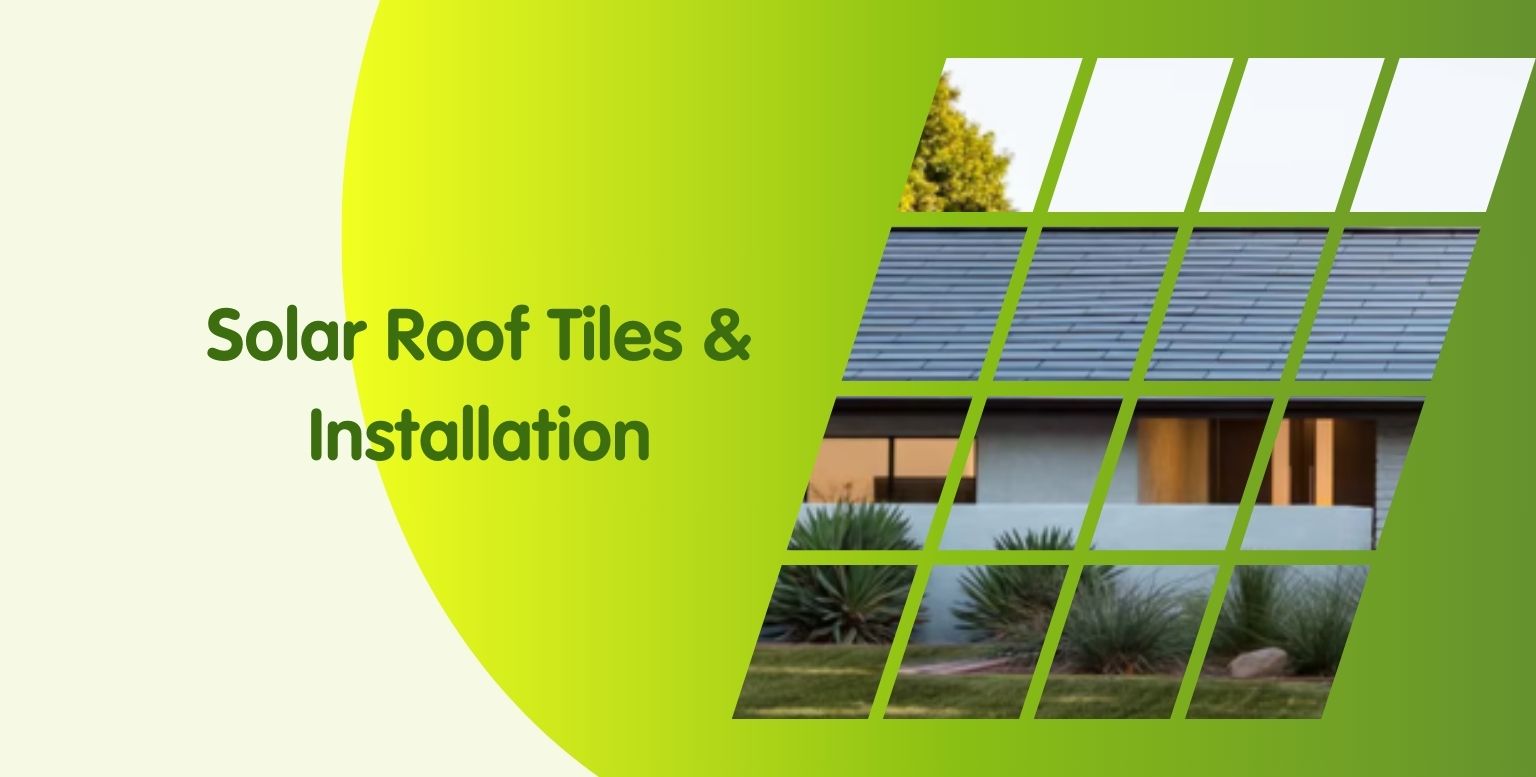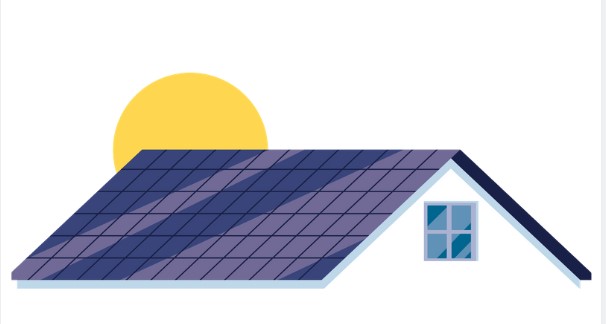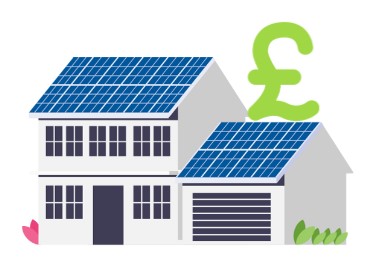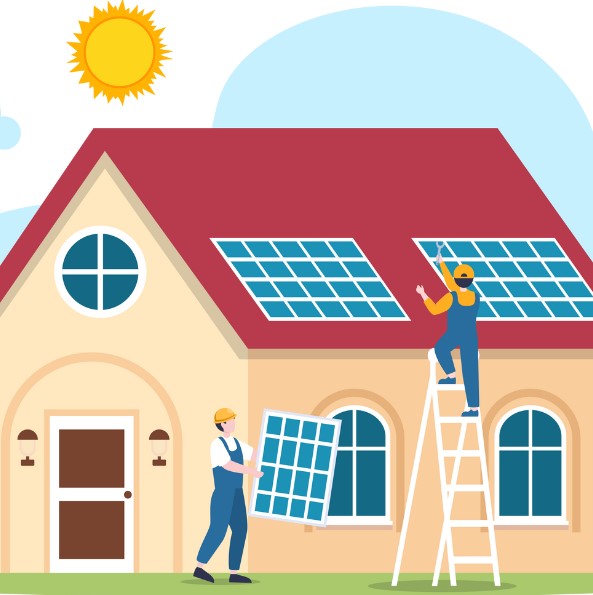Your basket is currently empty!
Written by
Solar Roof Tiles: Top Benefits & Costs Explained [2025]

Solar roof tiles are integrated into your roof to generate solar power seamlessly.
This article will explain how they work, their benefits, costs, and the considerations for choosing solar PV roof tiles for installation in your home.
Key Takeaways
- Solar roof tiles provide an aesthetically pleasing alternative to traditional solar panels, integrating into the roof structure while generating renewable energy.
- Installation costs for solar roof tiles are significantly higher than traditional solar panels, with complexities in the installation process contributing to overall expenses.
- While solar roof tiles offer long-term savings on energy bills, their lower efficiency rates compared to traditional types of solar panels can result in a longer payback period.
Solar Roof Tiles For Electricity
Solar roof tiles, also known as solar slates or solar shingles, are a revolutionary approach to integrating solar power into your home.
Unlike traditional solar panels that are mounted on top of the roof, in roof solar panels are built directly into the roof structure, offering a much more seamless and aesthetically pleasing alternative.
These tiles not only provide renewable energy but also help in reducing energy bills without compromising the visual charm of your home.
Solar roof tiles are particularly practical for new constructions or roof replacements.
They integrate seamlessly into the architecture while generating renewable energy. Nonetheless, evaluating the specific advantages and disadvantages is necessary before committing.
How Solar Roof Tiles Work

Solar roof tiles generate electricity using photovoltaic (PV) cells embedded within each tile.
These cells capture sunlight and convert it into direct current (DC) electricity. This DC electricity is then converted into alternating current (AC) by an inverter, making it usable for your home’s electrical needs.
Unlike traditional solar panels, which are often bulky and visually intrusive, solar roof tiles offer a more integrated solution that doesn’t sacrifice aesthetics for functionality.
However, several factors can affect the efficiency of solar roof tiles, including shading, roof orientation, and overall solar exposure.
Typically, the efficiency ranges from 10-20%, which is generally lower than that of traditional solar panels. Despite this, the technology continues to evolve, promising better efficiency and performance in the future.
Types of Solar Roof Tiles
There are two main types of solar roof tiles: monocrystalline and thin-film. Monocrystalline solar tiles are known for their high efficiency and longevity, making them a popular choice for homeowners seeking maximum energy output.
They are best suited for projects where efficiency and durability are paramount.
On the other hand, thin-film solar tiles offer greater flexibility and are lighter compared to monocrystalline tiles.
While they may not be as efficient, their lightweight nature makes them ideal for projects requiring a more adaptable solution.
Ultimately, the choice between these types will depend on your specific needs and the architectural requirements of your home.
Costs of Solar Roof Tiles in 2025
The costs of solar roof tiles in 2025 can vary widely, depending on several factors, such as the size of the installation, the type of tiles used, and the complexity of the roof design.

For an average-sized home in the UK, the cost of installing a 4kW solar roof tile system can range from £12,500 to £17,200, including labour.
This is significantly higher than the cost of solar panels, which typically makes solar roof tiles at least double the price of their conventional counterparts.
Factors affecting the total cost include materials, installation labour, and any additional expenses such as permits and electrical system upgrades. For instance, the total cost for a 4kW system with GB-Sol solar tiles, including installation, is around £15,500.
These factors should be taken into account when budgeting for your solar roof tile project.
Installation Costs
The installation process for solar roof tiles is generally more complex and time-consuming compared to traditional solar panels.
This complexity translates into higher labour costs, which can reach up to £4,000 for a 4kW system.
The initial installation expenses are notably higher due to the specialised skills required and the newer technology involved.
For example, installing Solecco Solar tiles costs around £3,500. The installation process can take about a week, longer than the one to three days usually needed for traditional solar panels.
These aspects significantly contribute to the overall cost of solar roof tiles.
Long-term Savings
While the initial investment is high, the long-term savings can be substantial. Homeowners can reduce their electricity bills by up to 64% with solar roof tiles.

This significant reduction in energy bills makes solar roof tiles an attractive option for those looking for long-term financial benefits.
Moreover, homeowners can get paid for any unused solar power generated by their roof, adding another layer of financial incentive.
Over time, these savings can offset the initial costs, making solar roof tiles a worthwhile investment for many.
Leading Solar Roof Tile Brands in the UK
Several leading brands in the UK offer high-quality solar roof tiles, each with its unique advantages.
Among the top manufacturers are GB-Sol, XO Edge, and Solecco, all of which provide durable, efficient, and aesthetically pleasing options for homeowners to buy solar roof tiles.
GB-Sol, for instance, specialises in highly durable solar panel roof tiles designed for efficient energy production. Solecco Solar tiles come in multiple colours and are designed to blend seamlessly with various roof styles.
XO Edge offers eco-friendly options made from recycled plastic, making them a sustainable choice for modern homes.
GB-Sol Solar Roof Tiles
GB-Sol manufactures its solar roof tiles in Wales, supporting local production and ensuring high-quality standards.
These tiles are known for their durability and high energy output, with peak performance reaching up to 28kW.
The warranty for GB-Sol solar roof tiles typically ranges from 25 to 30 years, offering long-term reliability and peace of mind for homeowners.
Suitable for a variety of building types, GB-Sol tiles provide a blend of functionality and aesthetics that can enhance any home.
XO Edge Solar Roof Tiles
XO Edge solar tiles are made from recycled plastic, making them an eco-friendly option for environmentally conscious homeowners. The peak performance rating of these tiles is 12W, and approximately 84 tiles are required for every kilowatt of output.
Pricing for XO Edge solar roof tiles varies greatly due to the bespoke nature of each installation. This brand is particularly suitable for those looking to make a sustainable choice without compromising on quality or performance.
Solecco Solar Roof Tiles
Solecco Solar offers a range of finishes and versatile tile colours, making it easy to find a style that complements your home. With eight color options available, homeowners can choose the aesthetic that best suits their preferences.
The estimated cost for Solecco’s solar tiles is over £11,500 before labour, making them a premium option. Solecco also provides non-solar tiles as an alternative if a full solar roof is not required, offering flexibility in design and functionality.
Advantages of Solar Roof Tiles
The main benefits of solar roof tiles include their aesthetic appeal, durability, and energy efficiency.
Unlike traditional solar panels, solar roof tiles blend seamlessly into the roof, maintaining the visual charm of your home.
This makes them an excellent choice for homes in conservation areas or for homeowners who prioritise aesthetics.
Moreover, solar roof tiles are extremely tough and built to endure strong weather conditions, making them more durable than traditional roofing materials. This durability means they won’t need to be replaced as frequently, offering long-term savings and reliability.
Aesthetic Appeal
One of the most significant advantages of solar roof tiles is their aesthetic appeal. These tiles are integrated solar panels into the roof, maintaining the home’s visual charm while providing renewable energy.
Solecco’s tiles are available in eight different colours, enabling homeowners to select a design that complements their home.
Durability and Weather Resistance
Solar roof tiles are designed to be extremely durable and weather-resistant.
With reputable manufacturers offering warranties exceeding 25 years, these tiles are built to withstand severe weather conditions and provide long-term reliability.
Their durability means they outlast traditional roof tiles, reducing the need for frequent replacements.
Energy Efficiency
Although solar roof tiles generally achieve an energy efficiency of around 10-20%, which is lower than most efficient solar panels, the technology is continuously evolving.
As the efficiency levels improve over time, tesla solar roof tiles are expected to generate more electricity, making them an increasingly viable option for homeowners.
Disadvantages of Solar Roof Tiles
Despite their many advantages, solar roof tiles do come with some drawbacks:
- Higher upfront cost compared to traditional solar panels
- Lower energy efficiency, generally ranging from 10% to 20%
- Generate less electricity
- Longer payback period compared to traditional solar panels
Another challenge is the limited availability of qualified installers, which can make the installation process more complicated and costly. These factors should be carefully considered when deciding whether solar roof tiles are the right choice for your home.
Higher Initial Costs
The higher initial costs of solar roof tiles are a significant barrier for many homeowners.
These costs are driven by several factors, including the manufacturing process, the dual function of the tiles as both roofing and energy generation, and the complexity of the installation process.
Additionally, installing solar roof tiles on an existing roof requires extra work, such as stripping the existing tiles and managing the new installation, further increasing the costs.
Despite these higher costs, the long-term savings and aesthetic benefits may justify the investment for some homeowners.
Lower Efficiency
Solar roof tiles generally have lower efficiency rates compared to traditional solar panels, typically ranging from 10% to 20%.
This lower efficiency results in reduced savings on electricity bills and a longer payback period due to less electricity generation.
While the aesthetic design of solar roof tiles is a significant advantage, it can also contribute to their slightly reduced energy efficiency. These factors should be considered when choosing between solar roof tiles and traditional solar panels.
Installation Process for Solar Roof Tiles
Installing solar roof tiles is more complicated than setting up traditional solar panels. It also takes more time to complete the installation.
This complexity is partly due to the need for precise installation to ensure weatherproofing and optimal performance. The entire process typically takes around two weeks, significantly longer than the one to three days required for traditional solar panels.
Furthermore, the limited availability of qualified installers can make the installation process more challenging and costly, especially in less populated areas.
Despite these challenges, solar roof tiles offer a durable and aesthetically pleasing solution for renewable energy generation.
Preparation and Planning
Preparation and planning are crucial steps in the installation of solar panels process for solar roof tiles. Homeowners need to consider factors such as the pitch angle of the roof, potential shading from nearby structures, and the electrical capacity of the home.
Obtaining the necessary local permits and approvals is also essential before beginning the installation.
Installation Steps
The installation steps for solar roof tiles involve removing the old roof, installing the tiles, and ensuring they sit flush with the roof surface for optimal performance.
This process typically takes a week or longer to complete, depending on the complexity of the roof design and the availability of qualified installers.
Post-Installation Maintenance
Regular inspections are essential for maintaining the performance and longevity of solar roof tiles. These inspections can help identify and address potential damages early, ensuring that the tiles continue to generate electricity efficiently.
Are Solar Roof Tiles Worth It?
Deciding whether solar roof tiles are worth the investment depends on various factors, including your budget, aesthetic preferences, and energy needs.
Although solar roof tiles have a higher initial cost than traditional solar panels, they provide a unique combination of functionality and visual appeal that can increase property value.
For homeowners prioritising aesthetics and willing to invest in a long-term solution, solar roof tiles can be a worthwhile option.
However, the lower efficiency and higher costs may not make them the best choice for everyone.
Traditional solar panels generally offer a quicker return on investment due to their higher efficiency and lower upfront costs.
Therefore, it’s essential to carefully evaluate your specific situation and long-term goals before making a decision.
Summary
Solar roof tiles represent a significant advancement in renewable energy technology, offering a visually appealing and durable alternative to traditional solar panels.
While they come with higher initial costs and lower efficiency, their long-term benefits, including reduced energy bills and enhanced property value, can make them a worthwhile investment for many homeowners.
As the technology continues to evolve, solar roof tiles are becoming more efficient and price-competitive, making them an increasingly viable option.
Whether you prioritise aesthetics, durability, or energy independence, solar roof tiles offer a compelling solution for harnessing solar power and contributing to a sustainable future.
Frequently Asked Questions
What are solar roof tiles?
Solar roof tiles, or solar shingles, seamlessly integrate into roofing materials to generate renewable energy while maintaining your home’s aesthetic. They offer a functional and attractive alternative to traditional solar panels.
How much do solar roof tiles cost in 2025?
In 2025, solar roof tiles cost between £12,500 and £17,200 for a 4kW system, installation included, which is considerably more than traditional solar panels.
What are the main advantages of solar roof tiles?
Solar roof tiles offer aesthetic appeal and increased durability while significantly reducing energy bills by up to 64%. These benefits make them an attractive option for homeowners looking to enhance both their property and energy efficiency.
Are solar roof tiles worth the investment?
Solar roof tiles can be a worthwhile investment for homeowners who value aesthetics and long-term savings, although they come with a higher upfront cost and lower efficiency than traditional solar panels.
What are the leading solar roof tile brands in the UK?
The leading solar roof tile brands in the UK are GB-Sol, XO Edge, and Solecco, known for their durability, efficiency, and design options. Choosing the right brand depends on your specific needs and preferences.
Written by
Start Your Solar Project Today
Best Solar Panels & Battery Storage Installation Deals
We price match too!





